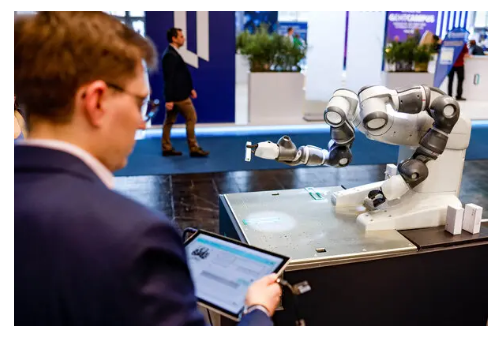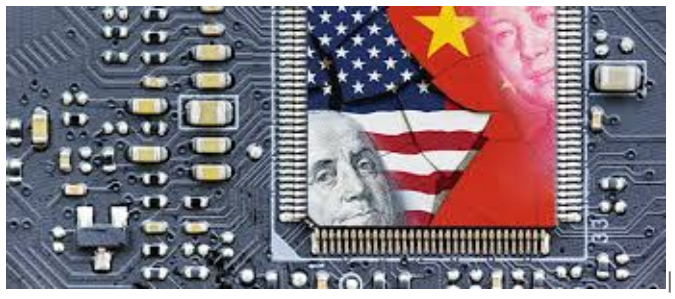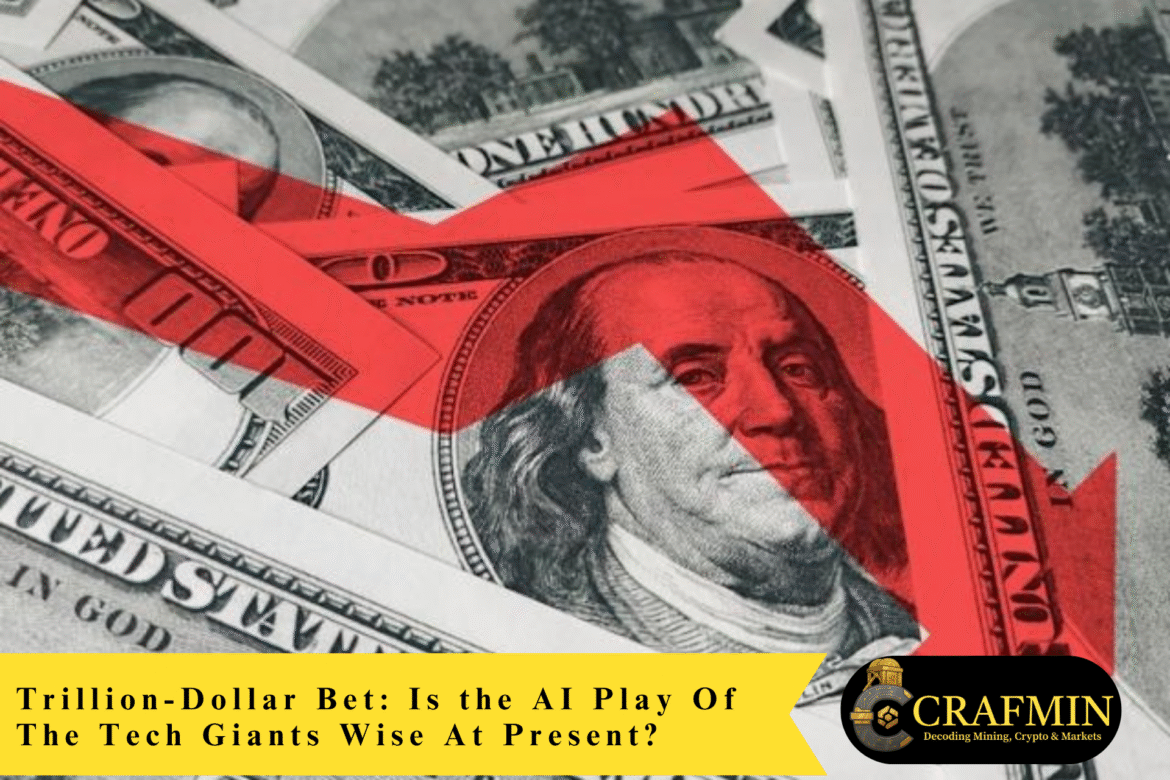Large tech companies are investing staggering sums in generative technology, data center networks, and dedicated chips, as investment monies already seem to add up to a trillion-dollar bet on the future economy. While some view the establishment of the infrastructure of the digital network of the future as a reality that has finally been achieved, others believe in the reality of a bubble.

Trillion-dollar AI gamble: future or bubble? (Image Source: The New York Times)
Quick Context
This year, hyperscalers and cloud companies as a whole are investing a total of hundreds of billions in the computation space. As per the latest calculations from the industry, as well as analysts attributed to 2025 plans for capital expenditure and AI development, the investments touch the figures of $300-400 billion. (goldmansachs)
What The Numbers Say And Why They Matter
Capex roadmaps of the big tech companies have a new dominant thread: AI. Google, Microsoft, Amazon, and Meta say their investment in data centers, custom silicon chips, and cloud infrastructure has climbed as AI systems needing generation and real-time support for large AI models are in high demand. Industry observers peg the total investment the industry will make in AI in 2025 at the low hundreds of billions.
The financials at Nvidia highlight the demand: Smarter chips used for training and executing large models create explosive growth in the financials of GPU companies. While Nvidia has just recorded its highest-ever data centre sales and made forecasts that have the market tuned to its plans. Where the chips lead, the data centres, the cooling solutions, and the fibre optics follow.
Why this outlay has a rippling effect in the market: Large capital expenditure programs translate to the purchase of semiconductors, racks, cooling solutions, power capacity, and construction. Capex isn’t the same as revenue. The burning question that investors tend to ask at the end of the day regards whether sufficient customer bases and monetization strategies for the next day will materialize.
Creating The Future: The ‘Bullish’ Scenario
Such an investment lays the foundation. Neither of these initiatives can simply be considered product releases. They develop dedicated infrastructure. This hardware enables the scaling of services. When generative AI changes the face of the health industry, the financial business, or logistics services, the early initiator has many advantages. Specific investment can include dedicated chips or private fiber.
Realized profits can also come indirectly. Clouds that are faster, have lower latencies, and more tools for developers can create markets that would not have existed a few years ago. From the perspective of stocks, it means greater gross margins for cloud services and new business engagements that lock customers into the ecosystems. This has been reflected in the last few months of stronger cloud revenue performance among hyperscalers.

AI spending builds faster clouds and bigger profits. (Image Source: LinkedIn)
A Fevered Rush: The Bearish Scenario
Skeptics would argue that the increasing losses and the monetization uncertainty remain. Certain divisions, based on the prospect of introducing a new product or hardware category, are burning money as they try to grow. Meta’s investments in extended reality and AI-based initiatives have triggered share price reactions due to the investors’ lack of patience. This share price volatility serves as a market indication that the money is not generating solid profits and should be re-evaluated.
Experts and historians of business urge that the trend follows the pattern of classic bubbles: the involved technology has promising expectations, money pours in, and stock price escalation outpaces the profit potential. A current review carried out jointly by academia and the world of business indicates that the rates of success concerning AI investments are less than the anticipated profit. (investmentnews)
Where The Line Between Build And Bubble Crosses: Preface
Certain dynamics add complexity to the assessment made below.
- Scale Vs. Speed: Setting up hyperscalers and the semiconductor chain takes a couple of years. However, the market expectations are for quarterly delivery. This creates visible tension between investors pressing the urgency for immediate returns versus the infrastructure allowing for returns over the decade.
- Winner Consolidation: Hard and platform synergies prefer a few companies. If the leading companies get dominant share together, their spending could lead to the creation of dominance because of the high investment cost. On the other hand, dominance can suffer from the ‘single point mistake,’ where one mistake can lead to very high expenses.
- Regulation and Geopolitics: Matters of trade regulations, export regulations, and national security issues influence the purchasing of semiconductors and the location of the data center. This could mean a very good technical guess can become a regulatory nightmare.
the overspending in “AI” infra (and datacenters in general) is so overdone they will be selling compute below the cost of electricity in the not-too-distant future
they are all betting there will be users to pay for it at the end of the tunnel–but the users are unwilling… https://t.co/r6zNIatM94 pic.twitter.com/TcoHsYtsZp
— T # (**not** brown backpack guy) (@StefanPatatu) October 31, 2025
Stories From The Front Line
A startup founder in the Sydney scene speaks of two different realities: “The infrastructure enables product teams to deliver features that wouldn’t have been possible a year ago. Yet the cost base is exploding. ‘We can build generative functionality overnight, but each model call has a price tag- and when scaled up, that price goes up to the boardroom table.’” This creates conservative pilots and long procurement cycles for the firm’s large customers.
On the other hand, a data centre contractor in regional Australia has recorded unprecedented interest in construction tenders as hyperscalers search for energy-efficient locations. Jobs rise sharply in the locality, so does the strain on the power network. This causes nearby regulatory authorities and power companies to scramble to keep up. Infrastructural development can become geographically localized and politically charged.
Where Money Has Become Material: The Tech Supply Chain
Investment patterns fall under specific buckets: chips and specialty silicon; data centres and networks; software stacks and dev tools; and talent. Each bucket has its own set of multidimensional economics. In the case of chips, the economy is driven by strong links to innovation and production. In the case of data centres, the economy relies heavily on land acquisition, zoning permits, and access to power.
Technicals That Signal Market Trend
The Following Formulas
Earnings calls and changes in guidance: As companies increase their capital expenditure guidance, the question comes up as to whether the capital expenditure is a strategic investment or if companies are chasing capacity. See the following example:
- Semiconductors and lead times: The strong interest in high-end accelerators drives hardware demand. Nvidia’s data illustrates how hardware demand can exceed market expectations.
- Profitability of new services: Is the new generative functionality monetized as subscription or transaction income or merely adding expenses? Cloud segments’ gross margin should be tracked.
What Regulators And Policymakers Are Worried About
The government monitors the trends related to national security, competition, and energy consumption. The usage of massive amounts of power in the form of huge data centers has serious implications related to the environment and the power grid; such effects are entering the domain of popular discourse. Export regulations related to chips and the national importance of local fabrication are at the core of national industrial policy.
Practical Considerations For The Investor And The Sleuth
In fact, avoid conflating outlays and immediate profit. Capex can be a long-term play.
Monitor the middlemen: The semiconductor industry, cooling solutions, or investments in the regional power grid tend to signal challenges or opportunities related to the supply side before other sectors.
Do not overlook the profit forecast and distinguish between the development of the platforms and sustainable monetization. Speculative long-term success can conceal profound weaknesses.

Watch costs, signals, and real profits: not hype. (Image Source: Global Consulting Oil Solutions)
Cases: Various Companies: Who Among Them Actually Puts Skin In The Game
Nvidia: How The Supplier Became The Market Beat
Nvidia’s financials are the pulse of the LTE Compute Era. Datacenter sales set new records in 2025. This highlights the importance of high-end computation: the entire stack rides the acceleration trend. Nvidia’s Blackwell generation chips are sold out long in advance. Their allocators are booked a year in advance. This creates both a positive signal and a traditional question: Can end-users create sufficient incremental revenue to pay for the ever-growing cost of the infrastructure required for their heavy computation activities at the end-user end? (nvidianews)
Microsoft Has Open Partnerships Role: The Art Of Platform-Building Versus Product-Building
Microsoft has built a cloud infrastructure as the foundation and applied proprietary software models and contract structures as the layering. The goal is to build long-term sticky revenue streams. Customers locked into a given platform and tooling chain won’t suddenly abandon it. The strategy: early-scale-derived pricing power in compute and services. This business model assumes large companies can change how they buy-which can be a slow process.
Google: Software And Silicon Code Design
Google has a mix of custom-chip innovation and datacenter-scale plus specialized services. Research and engineering to reduce cost per inference and develop new product segments are their aim. So their success could lead to the monetization of infrastructure services as cloud services and synergies of search and services. This will relate to the cost of implementation and rival oligopolistic rivals.
Amazon: Volume, Distribution And Business Reach
AWS competes through the blending of volume economics and worldwide delivery. AWS’ capital expenditure plans and capacity are important because the company provides the entry ramp for many start-ups and enterprises. When AWS expands capacity, the indirect beneficiaries are the third-party software vendors and integrators. However, the margins continue to face pressure until monetization.
Meta: The Expensive Experiment And The Existential Shift
Meta’s story of expenditure can actually warn other companies. Reality Labs, the business division responsible for VR/AR hardware as well as related experimentation, posts significant operating losses annually while keeping its income figures very low. Such a scenario indicates the dangers of investing in long-term platforms when immediate monetization isn’t involved. This results in the posting of massive losses that can deter investors, thereby necessitating restructuring. Meta has filed its quarterly report for 2025. (techinasia)
Scenario Modeling: Three Possible Futures
I’ve described three possible scenarios. Consider them more like lenses than predictions.
- Bull Case: Infrastructure As A Growth Driver (25% Probability)
Hyperscalers realize scale advantages in new high-margin services. Developers and enterprises become more receptive to real-time and computation-intensive services for generating recurring revenue. Hardware constraints reduce because the market adjusts. Government regulations remain manageable. According to this theory, the current capital expenditure creates monopolistic advantages. - Base Case: Slow And Irregular Monetization (Probability Of 55%)
Adoption occurs, but in a calibrated way. Enterprises progress to selective rollout phases. Clouds see revenue growth, but the profit structure reverts as price competition emerges. Certain projects sometimes die or expand very slowly. Market expands in total, but not as expected. Cap-ex businesses consolidate. Successful companies expand. Competing mid-tier businesses drive profits down. - Bear Case: Speculative Excess And Rapid Reprice (20% Probability)
Expenditure outstrips demand. Many expensive hardware and consumption themes blow their hype and fail to generate revenue. A liquidity crisis or government intervention suddenly causes a rethinking of the valuations. The market adjusts capital expenditure-weighted stocks. Industry chains suffer from the contraction in purchasing as well as layoffs. This scenario has been replicated in the traditional tech bubble cases where ‘hope’ has exceeded the actuals.
Triggers To Watch
- Earnings guidance that materially cuts future revenue expectations.
- Slowdowns in chip order volume, or forced write-downs of inventory at important sources.
- Significant regulatory actions related to exports, cloud competition, or data localization.
- Grid or local permitting issues can delay the implementation of data centres, especially in countries such as Australia.
Country Focus: Australia: An Opportunity With Real Constraints
There are plenty of reasons why hyperscalers find Australia appealing. This includes Australia’s stable politics and available renewables, as well as its qualified workforce. Australia’s proximity to the APAC market is also a factor.
However, the effects of growth are evident. An independent prediction of electricity consumption in the Australia-based datacenter shows a notable rise during the rapid phase of growth. This creates a dilemma for the concerned power authorities. In other words, the increase in the development of the data center creates job opportunities and business classes. On the other hand, power strain can now occur.
Local contractors say that the volume of bids has rocketed, together with the timeframe for gaining the consenting approvals. The utilities are tending towards facilitated connections as well as the option of exclusive off-takes for renewables. This makes for a two-tier solution whereby those locales locking in swift and inexpensive electricity get the campus development business, and those locales missing out could get no investment at all.

Australia’s data centre boom brings jobs and power challenges. (Image Source: The Guardian)
The Supply Chain: Vulnerability And Opportunity
The role of Hyperscalers cuts across more than the purchase of servers.
- Semiconductors: This industry has the advantage of shorter lead times among the world’s best-accelerator vendors. Nvidia sold-out notices: Such notices are important because cloud companies must allocate server time in advance.
- Construction/Electrical: Developers and construction companies operate in a boom environment but are also susceptible to cost inflation as well as labor shortages.
- Computing/Power: Efficiency, innovation and immersion cooling become important. Companies minimizing the power per inference will gain the most.
- Software/Tooling: Companies that lower the cost of ownership for corporations (cost per inference, observability tooling) extract more than just computational value.
All shocks in the bucket production, fabrication delay, price increase, etc.-start to cascade through the price and time effects.
Policy And Geopolitics: The Wild Card
Export regulations and national security considerations are influencing who to buy the fastest chips and where the most sensitive workloads are processed. In 2024-25, more countries imposed stricter regulations on the export of the best accelerators for cloud purposes. The implication appears to bifurcate the market areas to gain access to the sanctioned market, but others gain precedence to develop at the national level. This introduces the latest hurdle: world markets will not necessarily open for the best.

Chip export rules are reshaping global AI access. (Image Source: Global Trade Law Blog)
How Companies Can De-Risk Their Bets
- Emphasize strong value chains; focus on projects based on solid billing business models rather than speculating in the area of customer platforms.
- Invest in buy or build efficiency, i.e., investing in software/hardware codesign or cooling tech that drives the cost per unit down.
- Localization of strategy: Secure PPA contracts and regulatory support in each region.
- Roll out staged rollouts and hard stop gates: Use the R&D sprint cycles as revenue milestones before investing more capital.
Also Read: North Korea Cryptocurrency Hacking Hits $2.84 Billion In Global Thefts
Eye-Opening Tips For Investor-CTO Relationships
For Investors:
- View capital expenditure reporting critically. Not all capital expenditure creates immediate revenue.
- Observe the order books of the vendors for strong indications of market demand.
- Diversified exposure: Different behavior between the semiconductor/video software and infrastructure companies and the platforms.
For CTOs And Procurement:
- Minimize cost per inference rather than best-case latency advancements.
- Fixed price computation when possible. For the cost spikes, consider a Committed Use Discount.
- Ensure vendor neutrality when the risk of lock-in appears high.
Conclusion: A Prudent And Involved Stance
While the spending spree of the tech giants represents real infrastructure investment and optionality, the excess risk similarly weighs upon balance sheets and expectations. The most probable scenario falls somewhere in between: real value creation coupled with spectacular failures at great cost. For the investor as well as the policymaker, the correct strategies include strategic patience coupled with hard stop gates.
Frequently Asked Questions (FAQ)
Q: Approximately how much money are the BigTech companies currently investing in AI?
A: Industry forecasts for 2025 suggest the hyperscaler and cloud AI-related spend together will be in the hundreds of billions of dollars. This has been commonly referred to in the $300-400 billion area.
Q: What companies reap the most benefits from AI investment?
A: The immediate beneficiaries would include semiconductor companies like Nvidia, cloud service companies like AWS, Google Cloud, and Microsoft Azure, and other dedicated infrastructure companies. Software platforms and enterprises are the other category of companies that could benefit, as services can encompass related generative aspects.
Q: Is this a bubble that will burst? Historical Perspective
A: Experts disagree. On the one hand, some observers detect the classic bubble pattern: capital poured in very quickly and expectations were high. On the other hand, some argue that the money will create real infrastructure that will support new economic activity.
Q: What would prevent this collapse from becoming a true bubble?
A: If investment far outstrips the ability to adapt and profit for several particularly if the large players can’t realize profits from their infrastructure builds, the risk of repricing the market. Research studies reveal the dismal success rate of tech-related projects when ambitious implementation plans are involved.
Q: Approximately how much capital investment are hyperscalers currently making?
A: Estimates for 2025 suggest total hyperscaler capital expenditure in the low to mid hundreds of billions of dollars. Various industry sources suggest US$300-335 billion as a probable outcome for the year. This reflects the hot-growth strategies of the leading four cloud companies.
Q: Is the shortage of chips stifling progress?
A: In the short term, the answer is “yes” – the highest-end accelerators are at capacity. Customers are already placing orders months to a year in advance. The sold-out product pipeline and the revenue performance of the data-center business at Nvidia demonstrate how the shortage can continue despite robust market demand. Fabrication capacity and product diversification will slowly improve the outlook, but the road won’t be straight.
Q: Do “consumer interfacing” areas like the metaverse represent a lost cause?
A: No. In many countries, “expenditure” and “exceedingly slow” remain the reality. Meta Reality Labs is one example. Large operating losses coupled with very limited earnings suggest many more years will actually pass before reaching their serious-growth phase. This has the effect of forcing companies to balance very expensive dreams and develop cloud services that generate hard money.
Q: How can Australia gain the benefits at less risk?
A: Cooperative planning among policymakers must focus on quick access to the appropriate grid connections. An important factor should involve the off-take contract for renewables. Assess the inclusion of “community benefit” requirements as well as commitments for hiring local staff. They will improve the collective goals. “Independent” long-term forecasts will increase the acceptance of bankability.
Q: How will I know whether this represents the creation of real wealth or the creation of a bubble?
A: Consider “monetization velocity” – how quickly new services generate additional income. Observe the order books held by vendors. Assess the devaluation of products due to inventories. Determine the effects of “policy shocks” in the form of export regulations or grid capacity.

